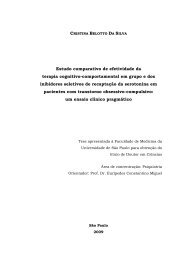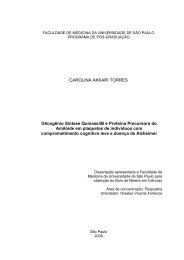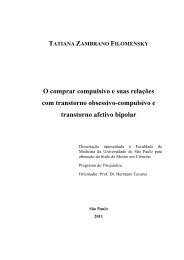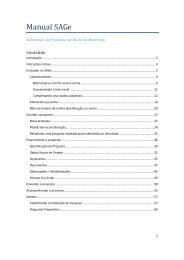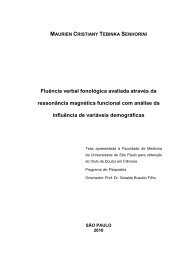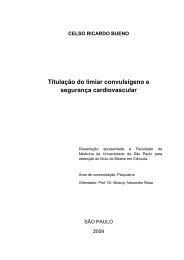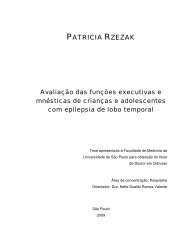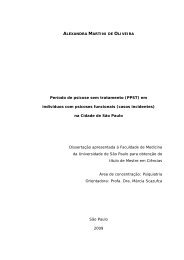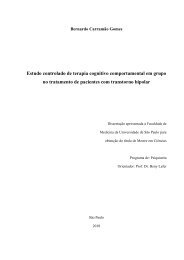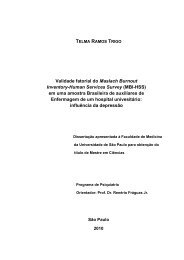Aspectos neuropsicológicos dos transtornos de ansiedade na ...
Aspectos neuropsicológicos dos transtornos de ansiedade na ...
Aspectos neuropsicológicos dos transtornos de ansiedade na ...
You also want an ePaper? Increase the reach of your titles
YUMPU automatically turns print PDFs into web optimized ePapers that Google loves.
____________________________________________________________SummaryRodrigues, Camila Luisi. Neuropsychological aspects of Anxiety Disor<strong>de</strong>rs inChildren and Adolescents: a comparative study between the pre and postpharmacologicaltreatment [dissertation]. São Paulo: “Faculda<strong>de</strong> <strong>de</strong> Medici<strong>na</strong>,Universida<strong>de</strong> <strong>de</strong> São Paulo”; 2011.The high level of anxiety may interfere with the performance of various cognitivefunctions. Thus, people with anxiety disor<strong>de</strong>rs are more vulnerable to the presence ofcognitive <strong>de</strong>ficits. Through neuropsychological testings, it is possible to measureperformance and, therefore, to <strong>de</strong>scribe potential changes in cognitive functions.Studies have pointed to <strong>de</strong>ficits in attentio<strong>na</strong>l processes, memory and executivefunctions. Since there are insufficient data in the literature on the cognitivefunctioning of young people with anxiety disor<strong>de</strong>rs, the aim of this study is toevaluate cognitive functioning in children and adolescents with anxiety disor<strong>de</strong>rs,before and after pharmacological treatment. The sample consisted of subjects (7-17years) diagnosed with generalized anxiety disor<strong>de</strong>r, separation anxiety disor<strong>de</strong>r and /or social phobia. Thirty subjects with at least one anxiety disor<strong>de</strong>r, assessed beforethe beginning of pharmacological treatment, and 34 healthy controls. Eighteensubjects with anxiety disor<strong>de</strong>rs were reassessed after they have been randomlyassigned (by table of random numbers) into three groups [clomipramine (n = 5),fluoxetine (n = 5) and placebo (n = 8)] and submitted to treatment for a period of sixmonths. Likewise, ten subjects in the control group were evaluated after the sameinterval of time. The instruments used in the neuropsychological tests were"Wechsler Abbreviated Sacal of Intelligence," "Trail Making Test," "Card StroopTest, Matching Familiar Figures Test-20", tests of verbal fluency for letters (FAS)and category (animals), "Wisconsin Card Sorting Test”, “Tower of Hanoi”, "Wi<strong>de</strong>Range Assessment of Memory and Learning-2", "Rey Complex Figure”. For theassessment of anxiety symptoms, the "Multidimensio<strong>na</strong>l Anxiety Scale for Children”was utilized. From the data observed, statistical comparisons were performed at twodifferent times: before and after treatment of subjects with diagnoses of anxietydisor<strong>de</strong>rs. Results from the pre-treatment evaluation suggest that subjects from the



